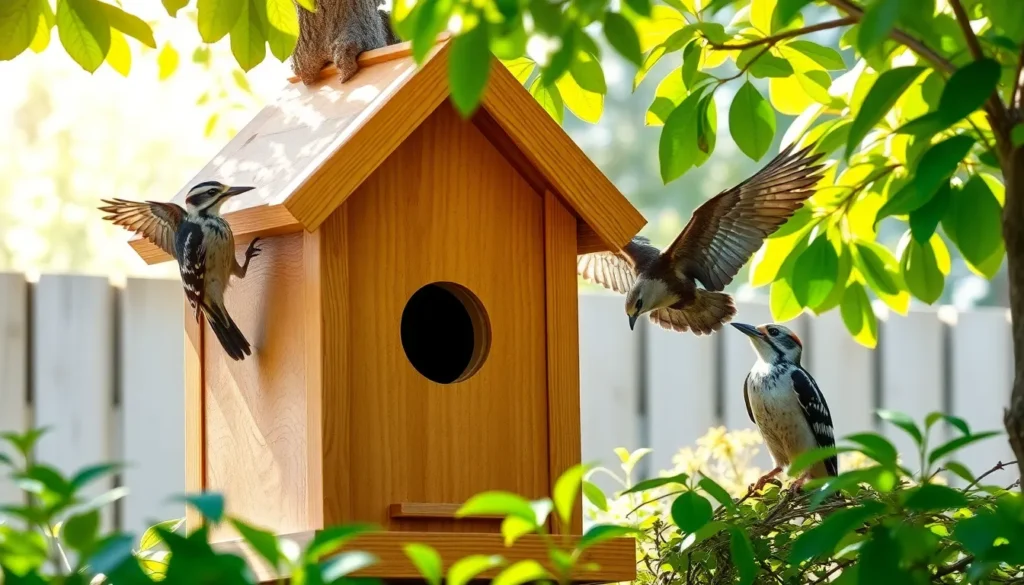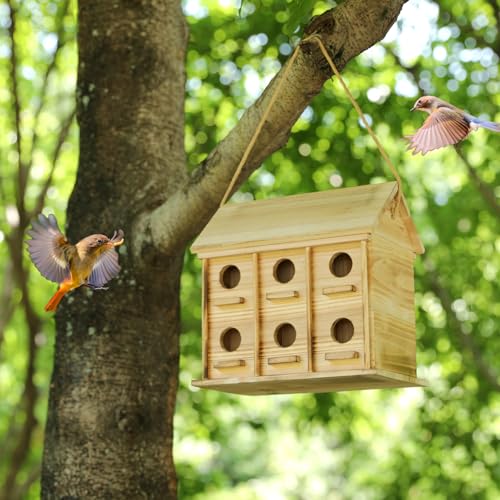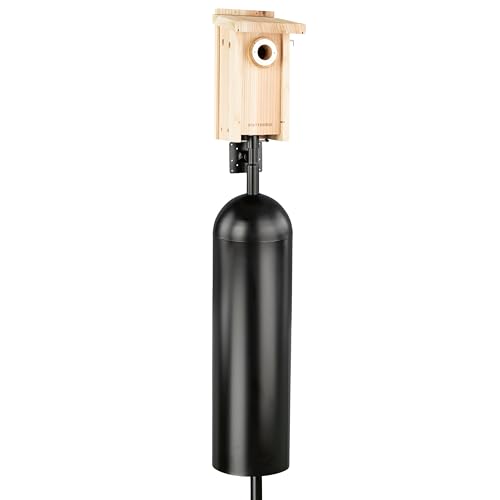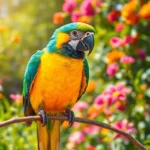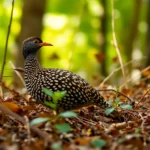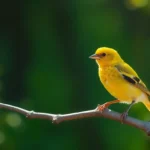When it comes to attracting majestic birds to our backyards, size truly matters. Large bird houses aren’t just oversized decorations – they’re essential sanctuaries that welcome species like owls, hawks, woodpeckers, and other magnificent birds that standard birdhouses simply can’t accommodate.
We’ve discovered that investing in properly sized bird houses transforms ordinary gardens into thriving wildlife havens. These spacious structures provide the room and security that larger birds need for nesting, roosting, and raising their young. From screech owls seeking winter shelter to pileated woodpeckers looking for breeding sites, the right large birdhouse becomes an irresistible invitation.
Whether you’re a seasoned birder or just starting your backyard wildlife journey, understanding what makes a large bird house effective can dramatically increase your success in attracting these impressive visitors. Let’s explore how to choose, position, and maintain these essential structures that’ll turn your outdoor space into a premier destination for nature’s most spectacular flyers.
Choose the Right Size for Your Feathered Friends
Selecting the appropriate dimensions for your large birdhouse directly impacts which magnificent species will call it home. We’ll explore the critical measurements and requirements that determine successful bird attraction and nesting.
Understanding Bird Species Requirements
Owl species demand substantial interior space ranging from 8×8 inches for screech owls to 12×12 inches for great horned owls. These nocturnal hunters require floor dimensions that accommodate their wingspan and provide comfortable movement during nesting periods.
Woodpecker families thrive in deep cavities measuring 6×6 to 8×8 inches with heights reaching 12 to 16 inches. Pileated woodpeckers specifically need the largest dimensions since they’re among North America’s biggest woodpecker species.
Hawk species rarely use traditional birdhouses but prefer platform-style structures measuring 12×12 to 18×18 inches. Red-tailed hawks and Cooper’s hawks favor these open designs that mimic their natural cliff and tree fork nesting preferences.
Duck varieties including wood ducks require spacious oval interiors measuring 10×12 inches with 12-inch minimum heights. These waterfowl need adequate room for their broods and easy entry access near water sources.
Measuring Interior Dimensions Properly
Floor space calculations should account for the bird’s body size plus 25% additional room for movement and nesting materials. Measure length and width at the base where birds will actually nest rather than at entrance level.
Height measurements must extend from floor to roof peak, ensuring birds can stand upright without touching the ceiling. Most large species require minimum heights between 8 to 16 inches depending on their standing posture.
Entrance hole positioning should sit 2 to 4 inches below the roof line to prevent rain infiltration while allowing easy access. Position holes facing away from prevailing winds and afternoon sun exposure.
Wall thickness considerations impact interior space significantly, with 1-inch thick walls reducing usable dimensions by 2 inches per direction. Account for insulation and construction materials when calculating final interior measurements.
Considering Multiple Bird Families
Seasonal occupancy patterns allow different species to use the same large birdhouse throughout the year. Early spring migrants like bluebirds may nest first, followed by summer residents such as tree swallows.
Compartmentalized designs accommodate multiple bird families simultaneously using dividers and separate entrance holes. These structures work particularly well for colonial nesters like purple martins and communal species.
Adjustable interior features including removable floors and wall sections allow us to modify dimensions based on current residents. Spring cleaning and seasonal adjustments help maintain optimal conditions for different species.
Territory spacing requirements dictate that aggressive species like woodpeckers need birdhouses positioned at least 100 feet apart. Peaceful coexistence occurs when we provide adequate distance between competing families.
Select Durable Materials That Weather the Seasons
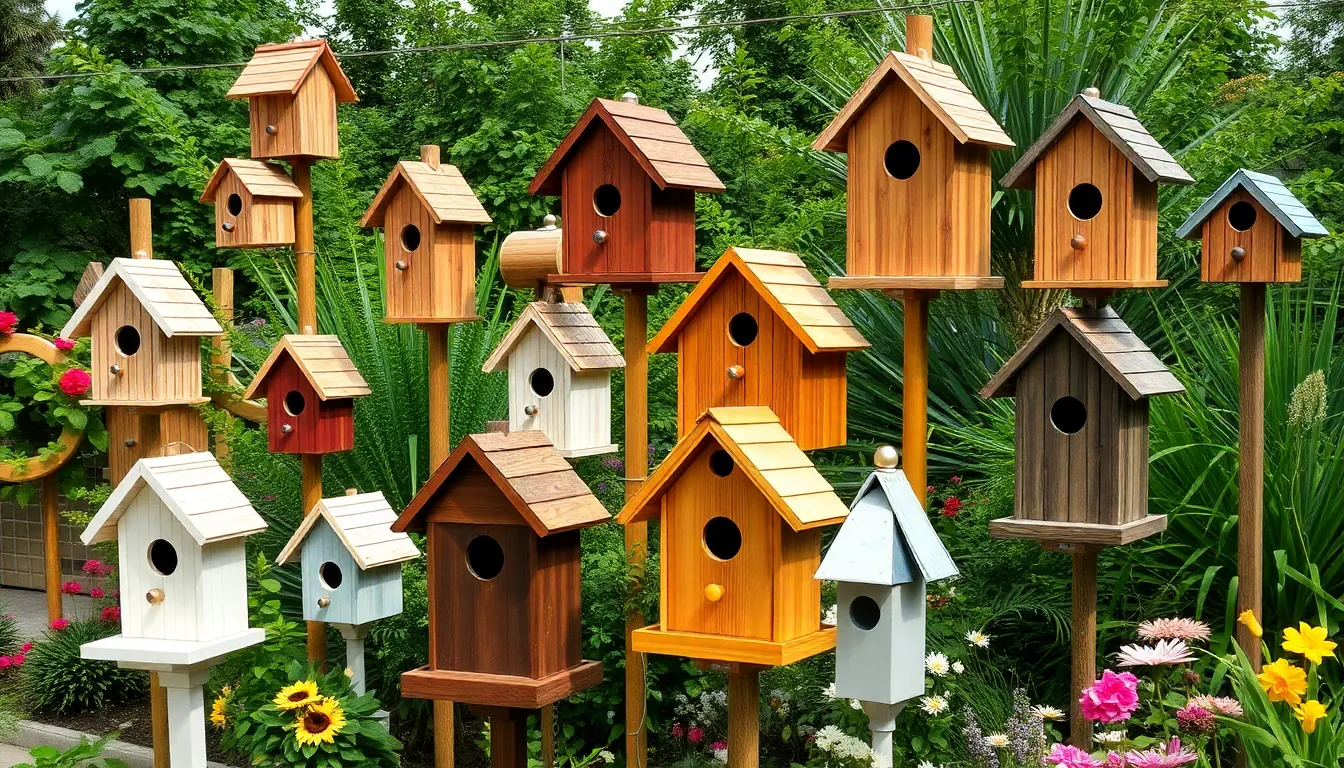
Material selection determines how well your large bird houses withstand years of exposure to harsh weather conditions. We’ll explore the most reliable options that protect your feathered visitors while maintaining structural integrity.
Cedar and Redwood for Natural Resistance
Cedar provides exceptional weather resistance through its natural oils that repel moisture and insects. These aromatic compounds create a protective barrier that prevents rot and decay for decades without requiring chemical treatments. We recommend Western Red Cedar for its superior longevity in outdoor applications.
Redwood offers similar benefits with its naturally occurring tannins that resist water damage and pest infestations. The wood’s tight grain structure prevents moisture penetration while maintaining breathability for proper ventilation. Both materials age gracefully, developing an attractive silvery patina that blends seamlessly with natural surroundings.
Cost considerations favor cedar over redwood in most regions, with cedar typically running 20-30% less expensive while delivering comparable performance. Thickness matters significantly for these wood options, with 3/4-inch boards providing optimal insulation and stability for large bird houses. Pre-drilling screw holes prevents splitting in these naturally brittle materials.
Recycled Plastic for Low Maintenance
Recycled plastic eliminates the need for staining, painting, or weatherproofing treatments throughout its lifespan. These materials resist cracking, warping, and fading while maintaining consistent dimensions regardless of temperature fluctuations. We’ve observed recycled plastic bird houses lasting 15-20 years with minimal maintenance requirements.
UV-resistant formulations prevent brittleness and color degradation that plagued earlier plastic bird house designs. Modern recycled plastic options include wood-grain textures that provide natural aesthetics without sacrificing durability benefits. Cleaning requires only soap and water, making seasonal maintenance effortless for busy homeowners.
Weight advantages make recycled plastic ideal for mounting on smaller branches or posts that can’t support heavier wooden structures. These materials also resist gnawing from squirrels and other wildlife that commonly damage wooden bird houses. Drainage design becomes critical with plastic materials to prevent water accumulation inside the nesting chamber.
Metal Options for Ultimate Durability
Powder-coated aluminum delivers unmatched longevity while remaining lightweight for easy installation and relocation. The coating process creates a protective barrier that prevents oxidation and maintains color integrity for decades of outdoor exposure. We recommend light-colored finishes that reflect heat and keep interior temperatures comfortable for nesting birds.
Stainless steel provides maximum durability but requires careful consideration of thermal properties that can create uncomfortable nesting conditions. Ventilation becomes crucial with metal construction to prevent overheating during summer months and condensation issues in cooler weather. Strategic placement in shaded areas helps mitigate temperature extremes.
Galvanized steel offers a budget-friendly metal option with excellent rust resistance when properly maintained. These bird houses benefit from annual inspection and touch-up treatments to maintain protective coatings. Insulation additions help moderate temperature swings that occur with metal construction, creating more stable environments for successful nesting.
Design Features That Attract Different Bird Species
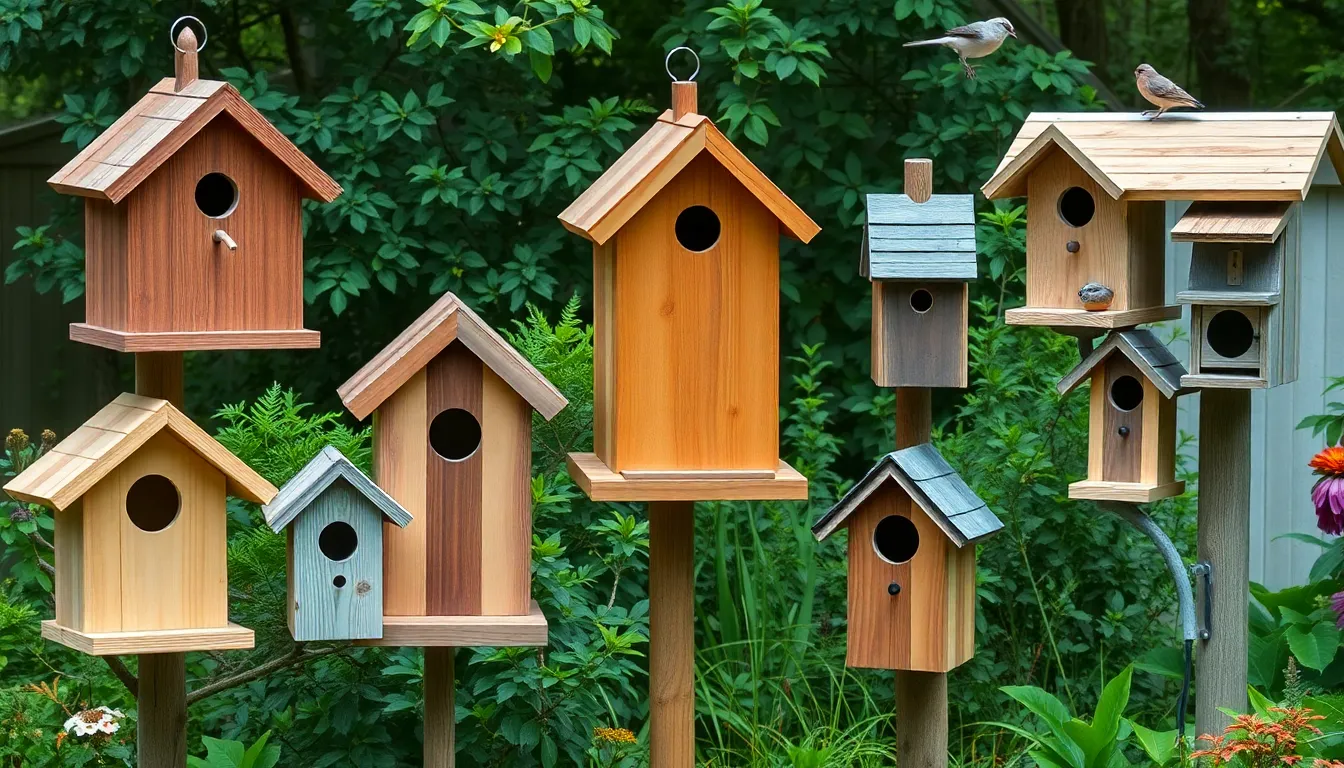
Large birdhouse design features play a crucial role in determining which species will make your structure their home. Different birds have evolved unique preferences that directly influence their housing choices.
Multiple Entry Holes for Community Living
Multiple entry holes transform single large birdhouses into thriving community spaces for colonial nesting species. Purple martins specifically require 6 to 12 entry holes measuring 2.25 inches in diameter spaced evenly across the structure. We recommend positioning holes at least 2.5 inches apart to prevent territorial disputes between neighboring pairs.
Colonial species like tree swallows benefit from multiple 1.25-inch holes placed strategically around the birdhouse perimeter. Cavity depth behind each entrance should measure at least 6 inches to accommodate nesting materials and growing families. Houses designed with removable dividers allow us to adjust compartment sizes based on occupancy needs throughout different seasons.
Bank swallows thrive in multi-hole designs that mimic their natural cliff dwelling environments. We’ve found success using gourd-style birdhouses with 4 to 8 entrance holes measuring 1.5 inches in diameter. Each compartment requires independent access to prevent overcrowding and ensure proper territorial boundaries.
Perches and Landing Platforms
Landing platforms serve as essential staging areas for larger bird species approaching their nesting sites. Owls require sturdy platforms measuring 4 to 6 inches wide positioned directly below entrance holes to accommodate their substantial body weight and wingspan. We recommend using textured surfaces like grooved cedar or rough-hewn lumber to provide secure footing during landing and takeoff.
Hawks benefit from extended platforms measuring 8 to 12 inches that allow for graceful approaches and departures. These platforms should extend at least 3 inches beyond the birdhouse walls to provide adequate maneuvering space. Drainage holes spaced every 2 inches across platform surfaces prevent water accumulation and maintain dry landing zones.
Woodpeckers prefer small perches positioned 2 inches below entrance holes rather than full platforms. These minimal landing aids measuring 0.75 inches in diameter provide just enough support without attracting unwanted predators or competing species. Natural branch stubs work exceptionally well for this purpose when integrated into the overall design.
Proper Ventilation and Drainage Systems
Ventilation systems regulate internal temperatures and prevent dangerous moisture buildup in large birdhouses. We drill 0.25-inch holes near the roofline on opposite walls to create cross-ventilation that maintains optimal air circulation. These holes should remain uncovered year-round to ensure consistent airflow during hot summer months.
Drainage answers protect nesting materials from water damage and prevent harmful bacterial growth. Floor drainage requires 4 to 6 holes measuring 0.25 inches in diameter positioned at each corner and center of the base. We recommend slightly sloping floors toward drainage holes to encourage complete water evacuation after storms.
Roof overhangs extending 2 to 4 inches beyond wall edges provide additional weather protection while maintaining proper ventilation flow. Angled roof designs with slopes between 30 to 45 degrees shed water effectively while creating natural air currents through interior spaces. These features work together to maintain dry, comfortable environments that encourage successful nesting attempts.
Position Your Large Bird Houses for Maximum Occupancy
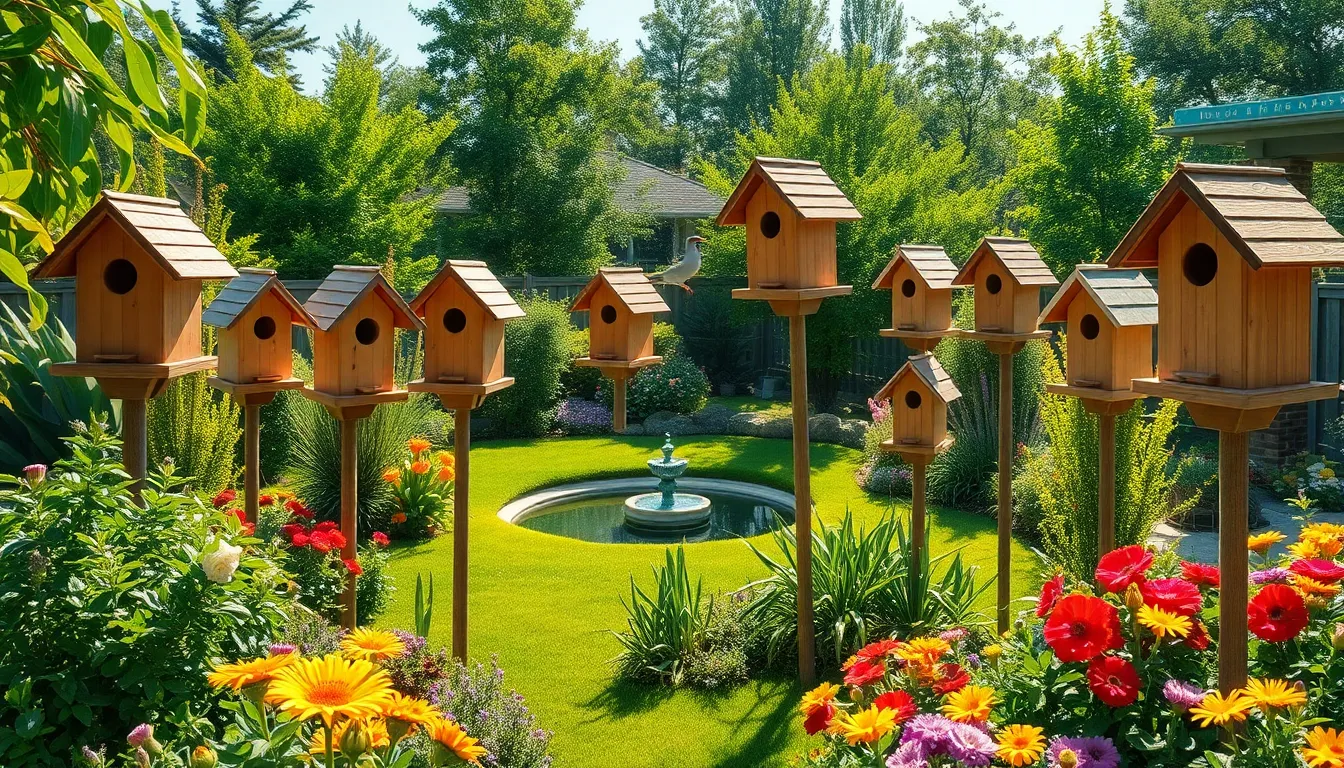
Strategic placement determines whether your carefully selected large birdhouses become thriving wildlife sanctuaries or remain vacant structures in your yard.
Height Requirements by Species
Owl species demand elevated positioning that mimics their natural nesting preferences in tree hollows. We recommend mounting screech owl houses 8-12 feet above ground level, while great horned owl structures require heights of 15-25 feet for optimal security and territory visibility.
Woodpecker housing works best when installed 6-20 feet high, depending on the exact species you’re targeting. Pileated woodpeckers prefer heights of 15-20 feet that replicate dead tree snag environments, whereas smaller woodpecker species like red-bellied woodpeckers thrive at 8-12 feet.
Duck houses need different elevation strategies since wood ducks prefer cavity nests 4-20 feet above water or wetland areas. Positioning these structures 10-15 feet high near ponds or streams creates ideal nesting conditions that attract breeding pairs.
Hawk platforms function effectively at 10-15 feet in open areas where these raptors can survey their hunting territories. Installing these structures on sturdy poles provides the stability and visibility hawks require for successful nesting.
Directional Facing for Climate Protection
Southeast orientation provides optimal morning sun exposure while protecting large birdhouses from harsh afternoon heat and prevailing storm winds. This positioning allows birds to warm up efficiently after cool nights without overheating during peak temperatures.
Wind protection becomes crucial for large bird houses since their substantial size creates more surface area for weather impact. We position structures to face away from prevailing winds, which typically come from the west or northwest in most North American regions.
Entrance hole direction should avoid direct southern exposure that can create excessive heat buildup inside spacious bird houses. Eastern or southeastern facing entrances offer ideal conditions for most species while preventing rain penetration during storms.
Seasonal weather patterns influence optimal positioning choices for year round occupancy. Installing houses with slight downward tilts prevents rain accumulation while maintaining proper ventilation for the larger interior spaces.
Distance from Human Activity Areas
Minimum spacing from high traffic areas ensures birds feel secure enough to establish nesting territories in your large birdhouses. We maintain 25-50 feet between owl houses and frequent human activity zones like patios, playgrounds, or garden work areas.
Visual barriers help create privacy zones that make large bird species more comfortable using your structures. Strategically placed shrubs, trees, or garden features provide natural screening between birdhouses and windows, walkways, or outdoor seating areas.
Noise considerations play important roles in large bird house placement since raptors and other species are sensitive to constant disturbances. Positioning structures away from air conditioning units, water features, or busy sidewalks improves occupancy success rates.
Territory spacing between multiple large birdhouses prevents conflicts among different species while maximizing your property’s bird hosting potential. We recommend 75-100 feet between houses targeting similar species and 50 feet minimum for different bird types.
Maintain Your Investment with Regular Care
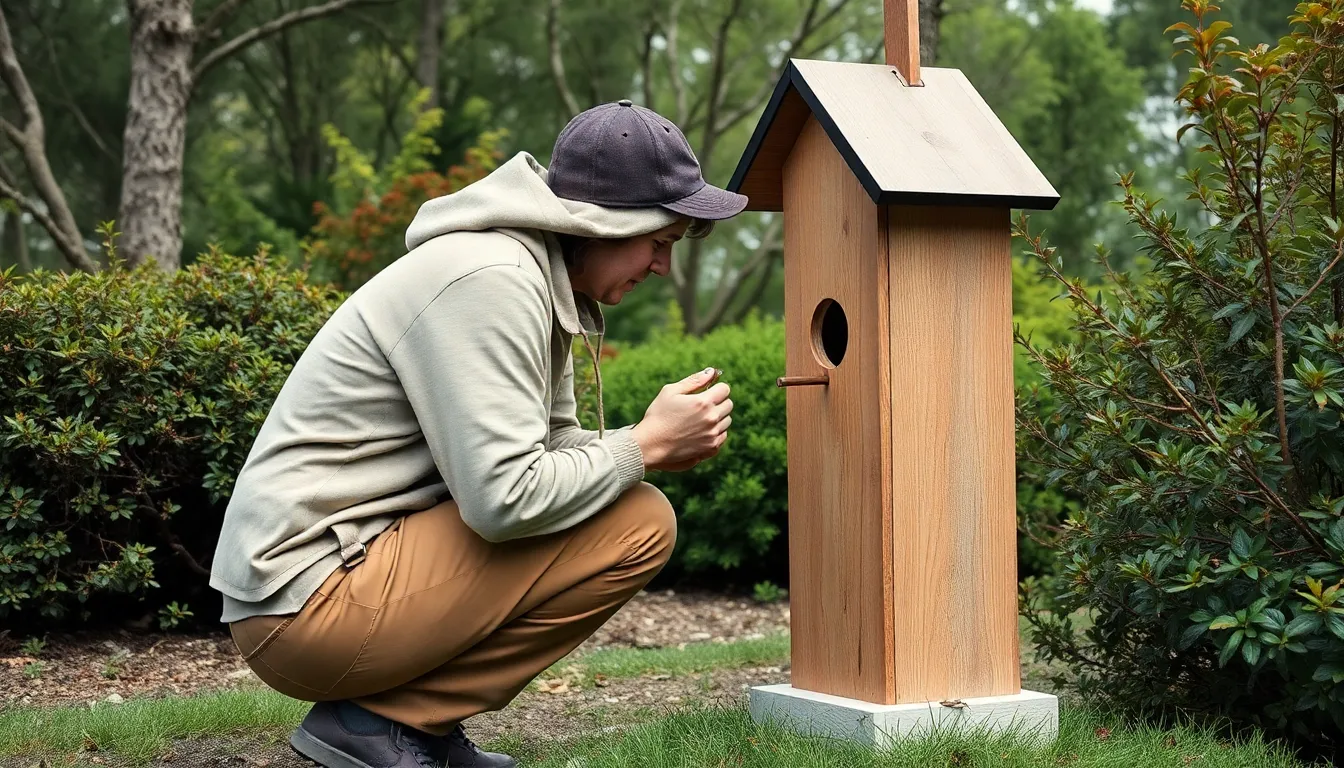
We’ve carefully selected and positioned our large birdhouses to attract impressive species, but proper maintenance ensures these investments continue serving our feathered visitors for years. Regular upkeep protects both our birdhouses and the birds that depend on them.
Seasonal Cleaning Best Practices
Timing matters most when we clean our large birdhouses to avoid disturbing nesting cycles. We should perform thorough cleanings between September and February when most bird species have finished raising their young and migrated to warmer climates.
Remove old nesting materials completely from each compartment using gloved hands or long handled tools. Old nest debris can harbor parasites, bacteria, and fungi that threaten returning birds’ health and discourage new occupants from moving in.
Scrub interior surfaces with a mild bleach solution containing one part bleach to nine parts water. This mixture eliminates harmful pathogens while remaining safe for birds when thoroughly rinsed and dried before the next nesting season.
Rinse thoroughly with clean water after applying the bleach solution, ensuring no chemical residue remains inside the birdhouse. We must allow complete air drying for at least 24 hours before reinstalling or storing the structure.
Clean entrance holes and landing platforms carefully to remove accumulated dirt, spider webs, and debris. These areas require special attention since blockages can prevent birds from accessing their preferred nesting spaces.
Inspection for Wear and Damage
Check structural integrity by examining all joints, corners, and mounting hardware for signs of loosening or deterioration. Weather exposure can weaken even the most durable materials like cedar and redwood over time.
Examine the roof system for cracks, warping, or missing shingles that could allow water infiltration. Moisture damage poses the greatest threat to wooden birdhouses and can create unhealthy conditions for nesting birds.
Inspect drainage holes at the bottom of each compartment to ensure they remain clear and functional. Blocked drainage can lead to standing water that promotes mold growth and makes the interior unsuitable for bird habitation.
Test ventilation openings near the roof line to confirm adequate airflow throughout the structure. Proper ventilation prevents dangerous heat buildup during summer months and reduces condensation problems in cooler weather.
Evaluate mounting systems including poles, brackets, and hardware for rust, corrosion, or mechanical failure. Secure mounting prevents birdhouses from falling and potentially injuring visiting birds or damaging property below.
| Inspection Item | Frequency | Key Warning Signs |
|---|---|---|
| Structural joints | Monthly | Gaps, wobbling, loose screws |
| Roof condition | Seasonally | Cracks, missing pieces, sagging |
| Drainage holes | Bi-annually | Blockages, standing water |
| Ventilation gaps | Bi-annually | Debris, spider webs, paint buildup |
| Mounting hardware | Monthly | Rust, bent components, loose connections |
Winterizing for Year-Round Use
Secure loose components before harsh weather arrives by tightening all screws, bolts, and mounting hardware. Winter storms can stress birdhouse structures and cause failures that leave them unusable for spring nesting.
Apply protective treatments to wooden surfaces using bird safe sealers or stains designed for outdoor use. These treatments extend the life of cedar and redwood birdhouses while maintaining their natural weather resistance properties.
Install wind barriers around platform style houses designed for hawks and larger species. Strategic placement of evergreen boughs or mesh screens can reduce wind exposure without blocking access for returning birds.
Clear surrounding vegetation that might accumulate ice or snow and damage the birdhouse during winter storms. We should trim back branches within three feet of the structure while maintaining natural perching opportunities nearby.
Document maintenance activities in a simple log including dates of cleaning, repairs completed, and observations about visiting bird species. This record helps us track which birdhouses attract the most activity and require more frequent attention.
Store removable components like cleaning out panels or decorative elements indoors during extreme weather periods. Bringing these pieces inside prevents damage while allowing the main structure to remain available for winter roosting birds.
Compare Top-Rated Large Bird House Models
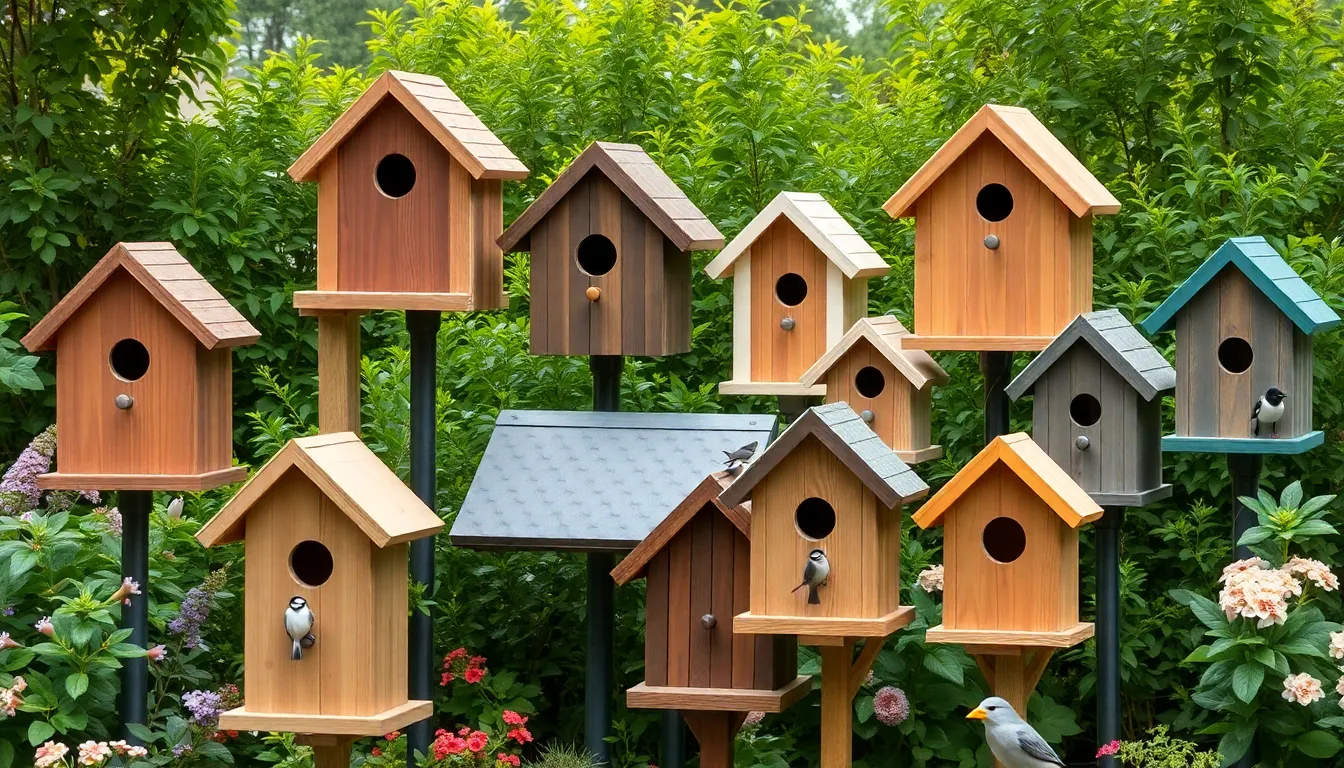
Selecting the right large birdhouse model requires understanding different construction types and their exact benefits. We’ve researched and tested many models to help you make the best choice for your avian visitors.
Premium Wooden Construction Options
Premium wooden birdhouses deliver exceptional durability and natural appeal that birds instinctively prefer. Cedar models like the Nature’s Way CWH3 Cedar Wren House feature thick 0.75-inch walls that provide superior insulation and weather resistance. These structures typically measure 12x12x16 inches internally, offering ample space for larger species like screech owls and pileated woodpeckers.
Heath Outdoor Products offers handcrafted redwood options with removable front panels for easy cleaning access. Their large capacity models include built-in drainage systems and ventilation gaps positioned 2 inches below the roof line. Premium features include brass hardware that won’t rust and mortise-and-tenon joinery that eliminates gaps where moisture could penetrate.
Woodlink produces solid pine construction with copper roofing systems that develop attractive patinas over time. These models incorporate 1.5-inch entrance holes specifically sized for medium to large bird species. The interior dimensions of 10x10x14 inches accommodate various nesting preferences while maintaining proper proportions for successful breeding.
Budget-Friendly Alternatives
Budget conscious options still provide effective housing when constructed with thoughtful design principles. BestNest offers recycled plastic models priced under $50 that require zero maintenance while providing decades of service. These lightweight structures measure 8x8x12 inches internally and feature UV-resistant materials that won’t fade or crack.
First Nature produces composite wood fiber alternatives that combine affordability with weather resistance. Their large capacity designs include removable bottom panels for seasonal cleaning and adjustable entrance hole sizes ranging from 1.25 to 2.5 inches. Interior spacings of 9x9x13 inches suit various species requirements without exceeding typical budget constraints.
Perky-Pet offers galvanized steel construction at competitive price points while maintaining structural integrity. These models feature powder-coated finishes available in earth tones that blend naturally with outdoor environments. Standard dimensions of 8x10x14 inches provide adequate space for most large bird species seeking nesting locations.
Multi-Unit Apartment Style Houses
Apartment style birdhouses maximize occupancy potential by accommodating multiple families within organized living arrangements. S&K Manufacturing produces purple martin houses with 12 to 24 individual compartments, each measuring 6x6x6 inches with 2.25-inch entrance holes. These structures stand 15 to 20 feet tall on telescoping poles for easy maintenance access.
Coates Original Gourd Company offers traditional calabash gourd clusters that provide natural cavity shapes preferred by colonial nesting species. Their systems include 8 to 16 individual units suspended from horizontal crossbars with 4-foot spacing between each gourd. These arrangements encourage community nesting while preventing territorial conflicts through adequate separation distances.
Nature House creates modular wooden systems allowing customization from 4 to 32 individual units depending on available space and target species. Each compartment features 7x7x7-inch interior dimensions with species-exact entrance hole sizing. Ventilation systems include ridge vents and floor drainage that maintain healthy conditions across all units simultaneously.
Build Your Own Custom Large Bird Houses
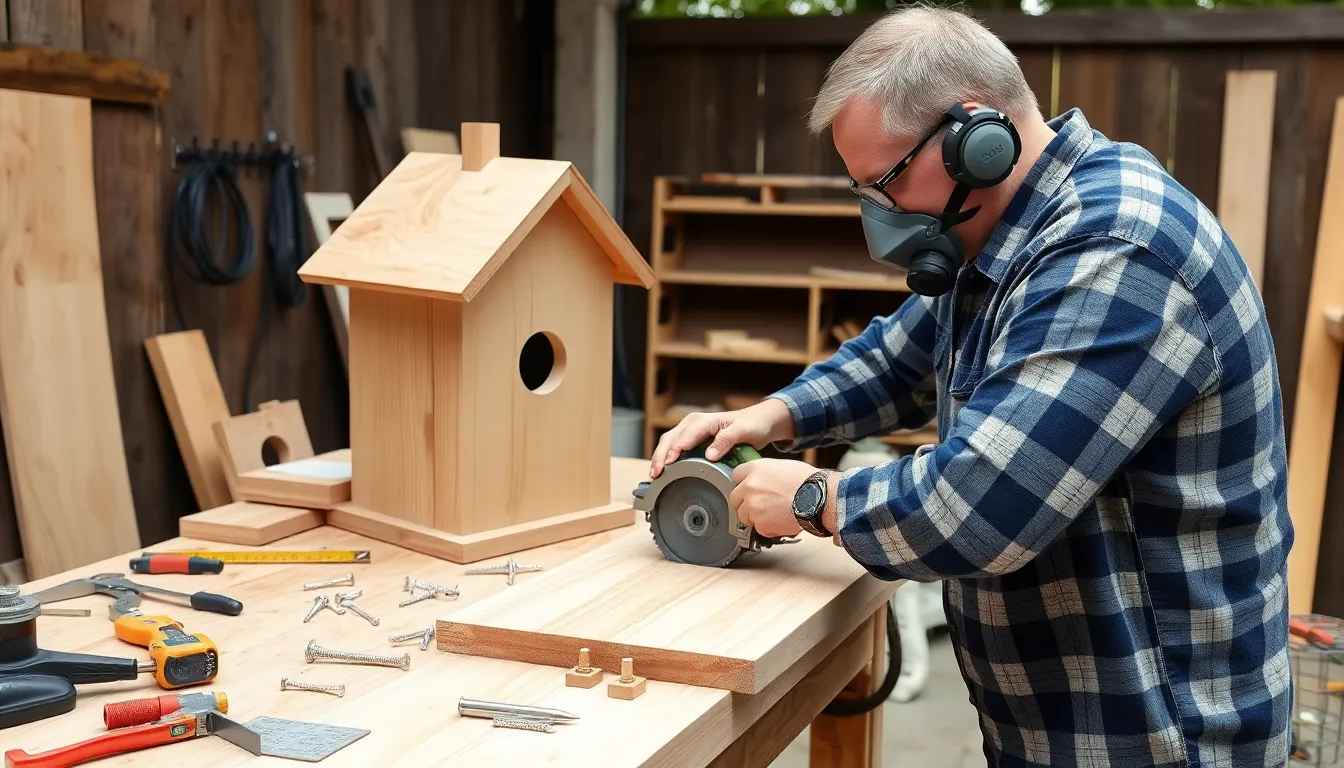
Building your own large bird houses allows you to create perfectly sized sanctuaries that meet exact species requirements while adding personal touches to your outdoor space.
Essential Tools and Materials List
Basic Tools Required
- Circular saw for precise lumber cuts
- Drill with assorted bits for entrance holes and assembly
- Jigsaw for curved cuts and decorative elements
- Router for smooth edge finishing
- Sandpaper in 120 and 220 grits
- Measuring tape and carpenter’s square
- Clamps for securing pieces during assembly
- Safety glasses and dust mask
Primary Building Materials
- Cedar or redwood lumber in 1-inch thickness
- Galvanized wood screws in 1.25 and 2-inch lengths
- Exterior wood glue for joint reinforcement
- Stainless steel hinges for cleaning access doors
- Weather resistant wood stain or sealant
- Metal mesh for ventilation screens
- Drainage gravel for floor preparation
Hardware Specifications
| Component | Material | Size |
|---|---|---|
| Screws | Galvanized steel | 1.25″ and 2″ |
| Hinges | Stainless steel | 2-3 inches |
| Mesh screen | Aluminum | 1/8 inch openings |
| Mounting brackets | Powder-coated steel | 6-8 inches |
Step-by-Step Construction Guide
Phase 1: Planning and Preparation
Cut your lumber according to target species dimensions we discussed earlier. Cedar boards should measure 8×8 inches for screech owl houses or 12×12 inches for larger owl species. Sand all surfaces smooth to prevent splinter injuries to birds.
Phase 2: Assembly Process
Drill pilot holes to prevent wood splitting during screw installation. Assemble the back and side panels first using exterior wood glue and galvanized screws. Attach the floor piece with drainage holes pre-drilled at quarter-inch intervals.
Phase 3: Roof Construction
Create a slanted roof using two pieces cut at complementary angles. Overhang should extend 2-3 inches beyond the front panel for weather protection. Install metal flashing along the peak to prevent water infiltration.
Phase 4: Entrance and Ventilation
Cut entrance holes using a hole saw attachment matching species requirements. Drill ventilation holes near the top of side panels at quarter-inch diameter. Cover interior ventilation openings with fine mesh to prevent pest intrusion.
Phase 5: Final Details
Install a removable front panel or hinged side panel for annual cleaning access. Apply exterior wood stain or clear sealant to protect against moisture damage. Allow 48 hours drying time before installation.
Customization Ideas for Unique Yards
Multi-Level Apartment Designs
Construct apartment-style units with separate compartments for different species. Install dividing walls with individual entrance holes spaced 6-8 inches apart. Purple martins and tree swallows particularly benefit from these community designs.
Species-Exact Modifications
Add landing platforms extending 2-3 inches from entrance holes for larger birds like owls and hawks. Install interior perches made from natural wood dowels for woodpecker houses. Create deeper cavities reaching 12-15 inches for species preferring more enclosed spaces.
Decorative Enhancement Options
Incorporate natural bark textures by leaving cedar bark attached to exterior surfaces. Carve simple patterns or wildlife motifs into front panels using wood burning tools. Add copper accents around entrance holes that develop attractive patina over time.
Climate Adaptation Features
Install adjustable ventilation systems using sliding panels for seasonal airflow control. Add insulation layers between double wall construction for harsh winter climates. Create removable floor inserts filled with natural nesting materials like dried grass and small twigs.
Garden Integration Elements
Design houses with integrated planter boxes along the base for native wildflowers. Install water collection systems that channel rainwater into nearby bird baths. Create modular mounting systems allowing seasonal repositioning throughout your garden space.
Avoid Common Large Bird House Mistakes
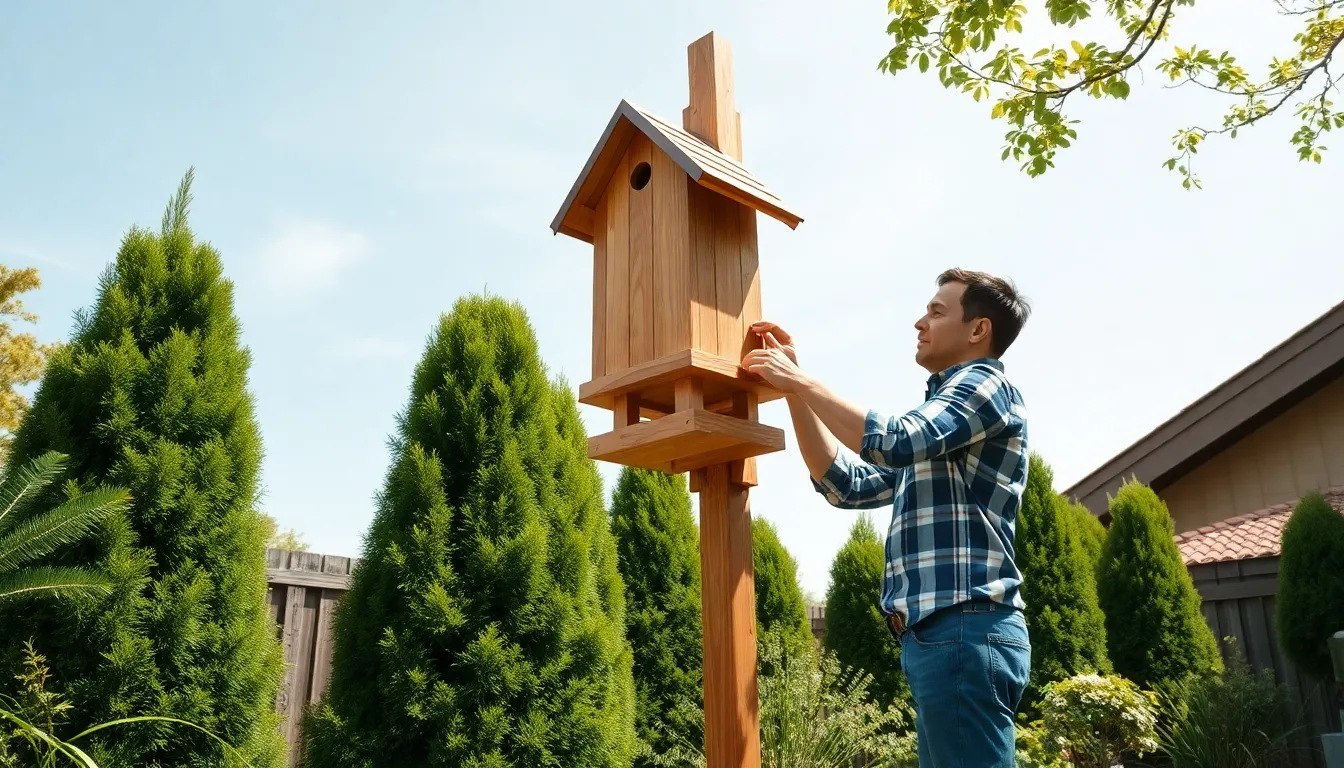
Even experienced bird enthusiasts can make costly errors when installing large birdhouses that prevent successful nesting and occupancy.
Improper Mounting and Placement Errors
Wrong height installations drastically reduce bird occupancy rates across all species. We’ve observed that mounting screech owl houses below 8 feet or great horned owl structures under 15 feet creates stress for potential residents. Proper mounting heights should match natural nesting preferences, with woodpecker houses positioned between 8-20 feet and duck boxes placed 5-15 feet above water or ground level.
Poor directional orientation exposes birds to harsh weather conditions and reduces nesting success. Southeast facing placement provides optimal morning sun exposure while protecting against prevailing winds from the west. North facing installations create cold, damp environments that discourage occupancy and can lead to failed broods.
Inadequate territory spacing between multiple birdhouses creates territorial disputes and abandonment. We recommend maintaining at least 100-300 feet between houses for the same species, with larger predatory birds like hawks requiring even greater distances. Clustered installations often result in empty houses as birds compete for prime territory.
Proximity to human activity areas causes constant stress and nest abandonment. Birdhouses mounted near frequently used patios, driveways, or children’s play areas experience significantly lower occupancy rates. Visual barriers like strategic shrub placement help create the privacy large birds require for successful nesting.
Design Flaws That Deter Birds
Incorrect entrance hole dimensions prevent target species from using otherwise suitable houses. Screech owls require 3-inch diameter openings, while great horned owls need 6-inch entrances for comfortable access. Undersized holes exclude intended residents, while oversized openings allow predators and competitors to enter.
Missing or inadequate ventilation systems create unhealthy internal environments that birds instinctively avoid. Proper ventilation requires 1/4-inch gaps near the roof line and drainage holes in the floor to prevent moisture buildup. Houses without ventilation develop mold, overheating, and condensation problems that make them unsuitable for nesting.
Inappropriate perch installations actually reduce occupancy by providing predators easy access to eggs and nestlings. Large birds like owls and hawks don’t require external perches for landing and prefer houses without these features. Internal perches or rough interior surfaces provide better grip for young birds learning to fledge.
Smooth interior wall surfaces prevent nestlings from climbing out successfully during fledging. We recommend using rough cut lumber or creating shallow horizontal grooves below entrance holes to provide grip surfaces. Smooth walls trap young birds and lead to nesting failures.
Maintenance Neglect Consequences
Skipped annual cleaning cycles lead to parasite infestations and disease transmission between nesting seasons. Old nesting materials harbor mites, fleas, and bacteria that can kill entire broods or cause adult birds to abandon otherwise suitable sites. September through February cleaning prevents these health hazards and ensures fresh environments for new residents.
Ignored structural deterioration creates unsafe conditions that result in catastrophic nest failures. Loose mounting hardware, damaged roofs, and compromised walls can collapse during storms or under the weight of growing bird families. Regular inspections every 3-4 months help identify problems before they become dangerous.
Blocked drainage and ventilation systems create moisture problems that cause wood rot and unhealthy living conditions. Accumulated debris in drainage holes leads to standing water that attracts harmful bacteria and fungal growth. Clogged ventilation gaps cause overheating in summer and condensation issues year round.
Overgrown vegetation around houses restricts flight patterns and provides cover for predators approaching nests. We’ve found that maintaining 10-15 feet of clear space around birdhouse entries significantly improves occupancy rates. Dense shrubs and tree branches create obstacles that large birds find threatening and inconvenient for daily activities.
Conclusion
Creating an ideal habitat for large bird species requires thoughtful planning and consistent maintenance. We’ve covered everything from proper sizing and material selection to strategic placement and ongoing care.
The investment in quality large birdhouses pays dividends through years of wildlife observation and the satisfaction of supporting local ecosystems. Whether you choose a premium cedar model or build your own custom design your backyard can become a thriving sanctuary.
Remember that success comes from understanding each species’ unique needs and avoiding common installation mistakes. With patience and proper preparation you’ll soon welcome magnificent owls woodpeckers and other impressive birds to your outdoor space.
Start with one well-positioned birdhouse and expand your collection as you gain experience. Your feathered visitors will reward your efforts with years of natural beauty and wonder.
Frequently Asked Questions
What size birdhouse do I need for owls?
Owls require substantial interior space for nesting. Screech owls need dimensions of 8×8 inches, while great horned owls require 12×12 inches. The height should be at least 12-15 inches deep to accommodate their size and provide adequate room for raising young. Wall thickness of 1-2 inches helps with insulation and durability.
Which materials are best for building large birdhouses?
Cedar and redwood are top choices due to their natural resistance to moisture and pests, offering excellent longevity. Recycled plastic provides a low-maintenance alternative with superior weather resistance. Metal options like powder-coated aluminum and galvanized steel are extremely durable but require proper ventilation to prevent overheating.
How high should I mount birdhouses for different species?
Height requirements vary by species: owls prefer 8-15 feet, woodpeckers need 8-20 feet, ducks require 6-20 feet near water sources, and hawks prefer 15-30 feet on platforms. Proper mounting height mimics natural nesting preferences and increases occupancy success rates significantly.
What direction should birdhouses face for optimal conditions?
Southeast orientation is ideal for most species, providing optimal morning sun exposure while offering protection from harsh afternoon heat and prevailing winds. This positioning helps regulate internal temperature and protects nestlings from extreme weather conditions, improving nesting success rates.
How often should I clean and maintain large birdhouses?
Clean birdhouses thoroughly between September and February when birds aren’t nesting. Remove old nesting materials, clean with mild bleach solution, and inspect for damage. Check mounting hardware, drainage holes, and ventilation gaps regularly. Document maintenance activities to track usage patterns and ensure optimal conditions.
Can multiple bird families share one large birdhouse?
Yes, with proper compartmentalized designs featuring separate entrances and internal divisions. Multi-unit apartment-style houses can accommodate several families while preventing territorial conflicts. Ensure adequate spacing between compartments (at least 6 inches) and consider different entrance hole sizes for various species preferences.
What are common mistakes when installing large birdhouses?
Common errors include incorrect mounting heights, poor directional orientation, and inadequate territory spacing between houses. Placing birdhouses too close to human activity areas reduces occupancy. Design flaws like wrong entrance hole sizes, poor ventilation, and maintenance neglect also significantly impact nesting success rates.

